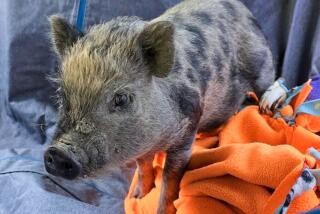Going Whole Hog
- Share via
“Never eat more than you can lift.” --Miss Piggy
*
One pragmatic pig, that. But only one of the provocative porkers to be found in the pages of “The Complete Pig” by Sara Rath, a Wisconsin native who earlier penned a pair of books about cows.
Yes, pigs are dirty--but that’s because they must wallow in mud to cool off, having been genetically deprived of sweat glands. And yes, pigs are fat. Rath duly notes that the heaviest hog on record was Big Bill of Tennessee, an impressive 2,552 pounds.
But are pigs stupid? Rath would have us know that they are innately intelligent and, indeed, that “learned pigs” enjoyed a surge of theatrical popularity after a trained suckling that could solve math problems and tell time debuted in 18th century Britain.
Should Regis ever inquire: A herd of pigs is called a drove. A hog is a pig that weighs 120 or more pounds. A virgin pig is a gilt. A weaner (not wiener) is a pre-adolescent pig. A barrow is a castrated male. A swine by any other name is just a plain old hog.
Why pigs? It wasn’t some inner voice telling Rath to spend almost a year of her life on porkers. In 1987, she’d written a cow book for another publisher. It was a quid pro quo, she explains--that publisher agreed also to publish her poems “and it’s so hard to get poetry published.”
After the cow book’s success, Voyageur publishing asked her to write “The Complete Cow” (1998) and then to do another animal book. “It was a draw between pigs and horses,” she says, and pigs seemed like more fun.
Rath has amassed an easy-reading book of pig factoids that will be eye-opening for those who think of the pig only as “the other white meat” or the inspiration for swineobilia collectors. Among these: a short treatise on flying pigs, a concept that, Rath notes, “perhaps due to the ludicrous image it conjures . . . has excited the imagination of would-be pig lovers for centuries.” In 1909, we learn, a Lord Brabazon, who held the first pilot’s license in Britain, went aloft with a piglet in a basket suspended from one wing. Tacked to the basket was a sign: “I am the first pig to fly.”
A few porcine vital statistics: The natural life span of a pig is 15 to 20 years. Pigs were on Earth 40 million years ago and are among the few large mammals found in every part of the world. A pig squeal can reach 115 decibels, three higher than the sound produced by the supersonic Concorde (thus, to squeal like a stuck pig).
Bacon and pork chops are hardly the pig’s only contributions to society. The pig sacrifices its blood for dyes, its bristles for brushes, its fatty acids for floor wax and cosmetics. Insulin, cortisone and estrogen are pig byproducts, and many a human heart beats with a pig heart valve.
In the category of “Did you know?” Rath tells us that Wall Street takes its name from a wall erected by colonial Manhattanites to keep herds of free-roaming hogs out of residential areas. And this: Queen Isabella of Spain’s sense of adventure went beyond bankrolling Christopher Columbus. A devout hunter, she was known “to slay a good-sized boar with her javelin.”
We learn too that pigs are survivors: When the atomic bomb was tested on Bikini atoll in the ‘50s, a sow jumped from a sinking ship and swam to safety through radioactive waters. The sow lived out her days at the National Zoological Park in Washington, a sterile 500-pound porker.
The pig’s rich contributions to the English language--or what Rath labels “porcine patois”--include pig Latin (igpay atinlay), male chauvinist pig, hog heaven, road hog and hogtied. Rath writes that “going whole hog” comes from 18th century England, when a shilling was known as a hog and a spendthrift in a pub might spend the lot. Eating high off the hog? That dates from the 19th century when enlisted men in the British army got lowly shoulder and leg cuts, while officers enjoyed the top loin.
The political patronage known as pork barrel has its origins pre-Civil War, when slaveholders would distribute salt pork to their slaves from huge barrels. And why are bad actors called hams? It’s derived from the term “hamfatter,” a reference to the custom of actors in the 19th century removing their makeup with ham fat in lieu of cold cream.
In early England, peasants would try to sell undersized pigs at market without opening the bag--called a poke--on the pretext that the piglet would escape. On occasion, a cat in the bag was foisted off as a pig. Thus, “buying a pig in a poke.”
The word barbecue was invented by French-speaking pirates, a bastardization of the name of a Caribbean pork feast, “de barbe et que” (roughly, snout to toe).
Long before the 1995 film “Babe,” pigs starred in literature, films and television. Perhaps the most famous is Winnie-the-Pooh’s pal, Piglet, created by A.A. Milne.
When Rath tells people she’s written a pig book, “They think that’s a big hoot--and it is funny--but it’s serious too.” She’s intrigued with “the paradox of the pig,” how in different cultures it is either revered or reviled, considered good or bad luck.
Now that she’s written books on cows and pigs, which animal does she think is smarter? Rath laughs. “Well,” she says, “I don’t think cows can be house-trained.”
More to Read
Sign up for our Book Club newsletter
Get the latest news, events and more from the Los Angeles Times Book Club, and help us get L.A. reading and talking.
You may occasionally receive promotional content from the Los Angeles Times.






